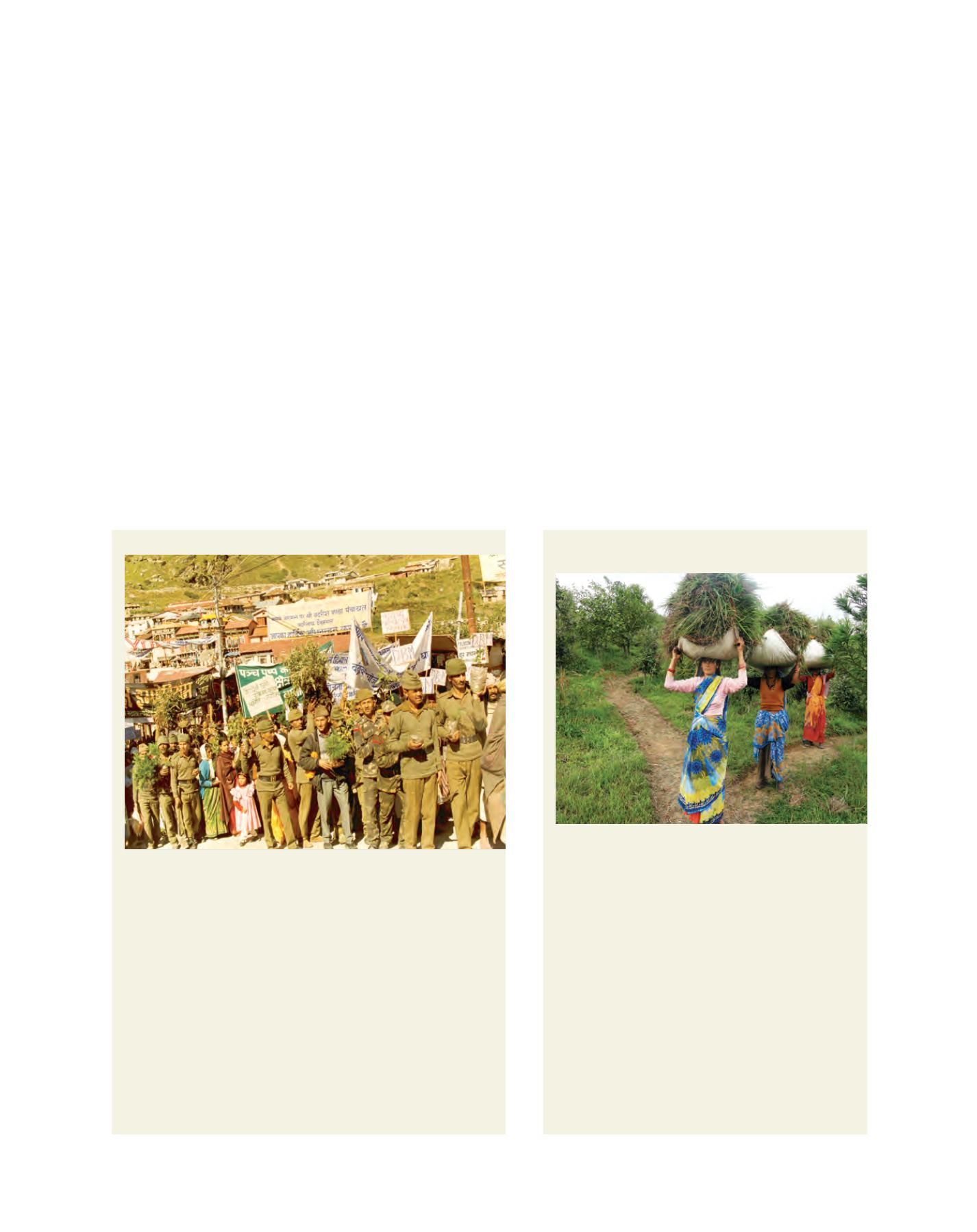

[
] 229
Planting the forest of Rakshavan by the Indian army
Establishment of a sacred forest by local
communities at Kolidhaik
The Indian army traditionally plants trees in high altitude areas, to
provide cover during operations, as a natural source of oxygen and to
relieve snow blindness in winter. The Badrinath reforestation programme
inspired the army to launch a similar initiative in Badrinath. The Garhwal
Scouts regiment carried out a project between 1998 and 2000 to
establish Rakshavan (a defence forest) on degraded defence land at
Dhantoli.
Army personnel promoted environmental awareness among the
locals, pilgrims and villagers of eight adjacent villages of Badrinath and
organized tree planting ceremonies.
A 10 hectare plantation site was developed at Dhantoli and almost
16,697 well-established and hardened saplings of various high-altitude
trees and shrubs were planted at the Rakshavan site. Out of these,
15,299 saplings of 11 high-altitude trees and shrubs were found to have
survived at the project site up to the date of completion of the project. In
addition, the army established a nursery of high-altitude trees and shrubs
within the plantation site. The army used seedlings raised and hardened
at the nursery for subsequent plantations. Several similar projects have
followed under the auspices of the Indian army in various locations.
Important lessons learned during the Badrivan restoration
programme at Badrinath led to a follow-up action
programme to create a forest for eco-restoration and
biodiversity conservation. The Sacred Forest Programme
(SFP) was executed at Kolidhaik village in the Kumaun
region of Uttarakhand between 2004 and 2007 with the
participation of local communities.
The programme addressed the need to reforest
community lands in and around the village at an altitude
of 1,740 metres. It was necessary to obtain the blessing of
both the imam of the mosque and the priest of the temple
in the village, both of whom agreed to become involved in
the project to undertake ritual plantings of around 8,000
tree seedlings.
Villagers from both religious groups responded
enthusiastically to the establishment of the sacred forest as
an act of devotion. A total of 6,200 seedlings of about 20
promising tree species had survived up to May 2007. The
forest was dedicated to Kail Bakriya (the local deity) and
felling of trees was banned, with the exception of fodder
collection for local families.
occurred in modern times with the Chipko movement for the preser-
vation of India’s forests, which in 1976 forced the Government to ban
commercial felling of green trees above an altitude of 1,000 metres.
Vegetation forms a green ‘security blanket’, protecting the fertile
yet fragile soil, maintaining balance in atmospheric conditions,
safeguarding supplies of fresh water and moderating their flow
to prevent flood and drought. The green cover, especially in our
forests, is under attack by the greed of the rich and the need of the
poor. This must be corrected
5
. As far back as 22 centuries ago, the
Emperor Ashoka defined a king’s duty as not merely protection of
citizens and punishment of wrongdoers but also, preservation of
animal life and forest trees. Along with the rest of mankind, we in
India – in spite of Ashoka – have been guilty of wanton disregard
for the sources of our sustenance
6
.
In Indian culture, trees have come to symbolize eternity, constancy
and unity of nature. Sages in India have long believed that gods
descend from heaven to Earth through the trees to communicate
with human beings. One of the old scriptures states: “The supreme
one infuses energy into the peaks of trees. Therefrom rays radiate
outwards from descending layered limbs. May they reside within us”.
7
Meditation traditionally took place while sitting under a tree against
its trunk as if to physically support a spiritual connection leading to
personal transformation. When we hear the story of the
forests we hear the voices of the future
8
.
Forests are also traditional sources of food, fuel,
fodder, fertilizer and fibre (the 5 essential ‘Fs’ for Chipko)
and forestry practices should improve the lives of forest
dwellers, whether human or other species. The reckless
exploitation of nature and especially of forests must there-
fore end. There is an urgent need to evolve programmes
through which forests can not only coexist but be
enlarged side by side with active community participa-
tion. The case studies that follow are based on the ethos
‘let us give back to Nature what we have taken from it
– creativity and capacity for renewal’. They illustrate the
merits of deploying an appropriate driving force, whether
spiritual, religious, traditional or customary practice, to
encourage the planting of trees, symbolizing our faith in
the future. Let this act of faith (and investment) in the
future grow, particularly during this International Year
of Forests, 2011, inspiring change, enhancing value and
securing our own future. The ‘Katoupanishads’ exhorts
us ‘to arise and awake and walk boldly across the razor
sharp path ahead’.
















